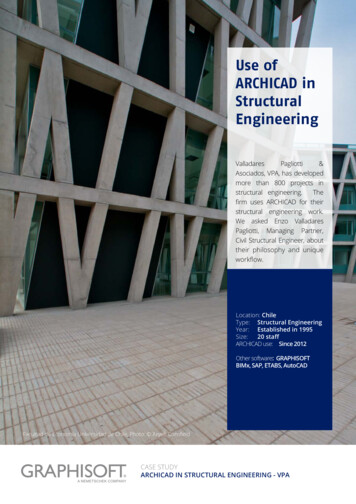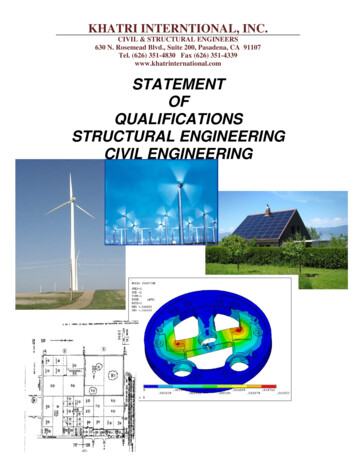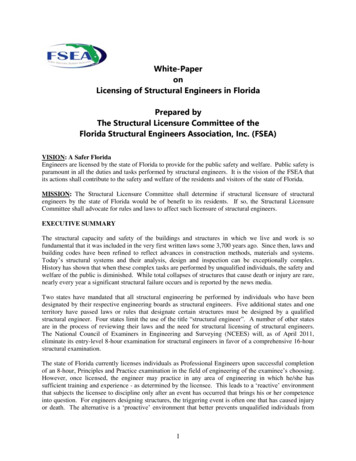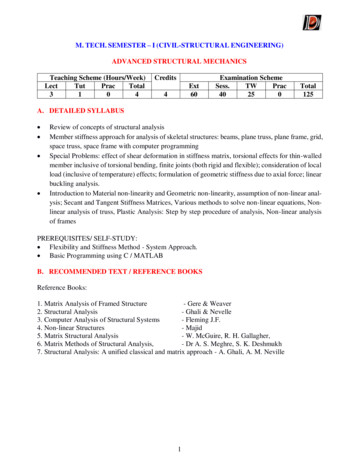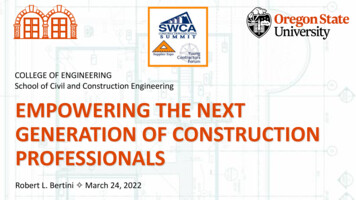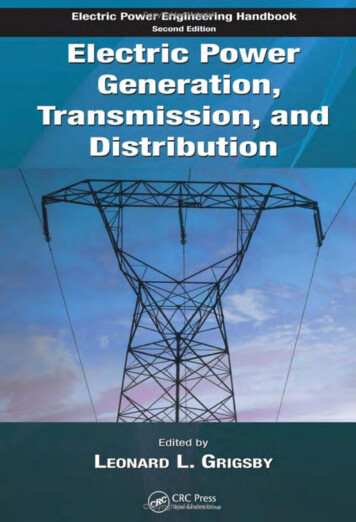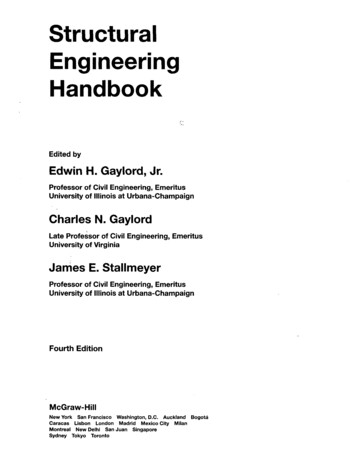
Transcription
StructuralEngineeringHandbookEdited byEdwin H. Gaylord, Jr.Professor of Civil Engineering, EmeritusUniversity of Illinois at Urbana-ChampaignCharles N. GaylordLate Professor of Civil Engineering, EmeritusUniversity of VirginiaJames E. StallmeyerProfessor of Civil Engineering, EmeritusUniversity of Illinois at Urbana-ChampaignFourth EditionMcGraw-HillNew York San Francisco Washington, D.C. Auckland BogotaCaracas Lisbon London Madrid Mexico City MilanMontreal New Delhi San Juan SingaporeSydney Tokyo Toronto
ContentsPrefacexvContributorsxviiSection 1 Structural AnalysisParti.Fundamentals and Applications to Structural Frameworks1-1David A. PecknoldIntroduction: Classification of Structures; Fundamentals of Analysis: Description ofStructural Configuration—Basic Principles— Static Determinacy and Stability—Superposition—Symmetry; Energy Principles: Principle of Virtual Work—Principle of MinimumPotential Energy—Principle of Minimum Complementary Potential Energy—The Reciprocal Theorem; Analysis of Statically Determinate Structures: Forces: Plane and SpaceTrusses—Beams and Frames—Beam Deflections; Analysis of Statically IndeterminateStructures: Comparison of Force and Displacement Methods; Force Method: StructureFlexibility Coefficients—Dummy Unit-Load Method Examples—Three-Moment Equation for Continuous Beams; Displacement Method: Structure Stiffness Coefficients—Member Stiffness Matrices—Member Fixed-End Forces—Portal Frame by DisplacementMethod—Slope-Deflection Equations—Moment Distribution—Matrix Formulation of theDisplacement Method—Frame Element Stiffness Properties and Equivalent Loads UsingVirtual Work; Nonlinear Analysis: Second Order Effects and Frame Stability: Characteristics of Nonlinear Response of Structures—Formulation of Nonlinear Structural Analysis Problems—Solution Methods for Nonlinear Structural Analysis Problems—Linearized Buckling—Second-Order Analysis of Frame Structures
vi Structural Engineering HandbookPart 2. Continua: The Finite-Element Method1-64William C. SchnobrichFinite-Element Method: Requirements for Finite-Element Analysis—Discretization ofthe Structure—Guidelines for Selection of Grid—Element Models—Plane-Stress andPlain-Strain Elements—Plane-Stress Analysis—Beam and Plate Bending—Shells andCombined Direct Stress and Bending—Three-Dimensional Problems—Element StiffnessMatrix and Nodal Force Vector—Equilibrium Equations for the Assemblage—Solution forthe Displacements—:Solution for Element Strains and StressSection 2Computer Applications in Structural Engineering2-1Steven J. FenvesIntroduction—The Computing Environment—Current Status—Data Capture—ConceptualDesign—Detailed Design—Modeling and Model ��Redesign and Optimization—Integration with Other Disciplines—Preparation of Design DocumentsSection 3Earthquake-Resistant Design3-1W. J. HallResponse of Simple Structures to Earthquake Motions—Earthquake Motions; ResponseSpectra: Elastic Systems—Design Response Spectra—Response Spectra for Inelastic Systems—Multi-Degree of Freedom Systems; Computation of Period of Vibration: Fundamental Mode—Higher Modes—Modal Participation Factors—Spring Constant forEquivalent Shear Beam; Design: General Considerations—Effects of Design on Behavior—Design Lateral Forces—Seismic Forces for Overturning Moments and Shear Distribution—Damping—Gravity Loads—Vertical and Horizontal Excitation—UnsymmetricalStructures in Torsion—Curtain-Wall Buildings—Core Walls—Parts of Buildings—Effectsof Soil Conditions—Detailing and Quality Control—Cost—Lifelines; Bridges: Overviewon Bridge Design—Design Considerations—Modelling and AnalysisSection 4Fatigue, Brittle Fracture, and Lamellar Tearing4-1W. H. Munse and S. T. RolfeFatigue of Structural Steel: Significance of Fatigue—Fatigue of Structural Steels—Factors Affecting Fatigue Strength—Structural Members—Riveted Connections—BoltedConnections—Welded Connections—Design for Fatigue—Protecting against Fatigue;Brittle Fracture of Structural Steel: General—Notch Toughness—Significance of Loading Rate—Introduction to Fracture Mechanics—Correlation Between Various FractureTest Results—Fracture Mechanics Design—Prevention of Brittle Fracture—LamellarTearingSection 5Soil Mechanics5-1H. G. LarewNature and Causes of Soil Deformation: Settlement—Frost Movements—Shrinkage—Subsidence—Soil Deformation—Time-dependent Deformation; Strength Properties ofSoils: Compressive Strength—Effect of Confining Pressures—Transient and RepeatedLoads; Factors Affecting Bearing Pressure: Allowable Bearing Pressure—PermissibleSettlement—Elastic-plastic Deformation—Shear Failures—Consolidation—Time Rate of
ContentsviiSettlement; Cuts and Embankments: Slope Stability; Compaction and Permeability:Compaction—Permeability; AppendixSection 6Subsurface Exploration6-1T. K. Liu and J. R. LambrechtsIntroduction: Intent of Subsurface Exploration Programs; Basic Exploratory Methods:Test Pits—Borings—Sampling—Boring Reports; Influence of Geology on Explorations:Sources of Information—Glacial Materials—Water-Laid Materials—Wind-Laid Materials—Organic Soils—Residual Soils—Frozen Soils; In Situ Investigations for Soil Properties: Strength and Deformation Properties—Dynamic Properties—Permeability;Surficial Geology and Remote Sensing: Surficial Geology—Remote Sensing—Geophysical Surveys; Load Testing: Plate Load tests—Pile Load Tests; Instrumentation DuringSubsurface Exploration Programs: Observation Wells and Piezometers—Ground Movements; Exploration Program: Site Reconnaissance—Fact-Finding Survey—Planning ExplorationsSection 7 Retaining Structures and Foundations7-1Herbert O. Ireland and James H. LongEarth Pressures: Stresses in Earth Mass—Rankine's Theory—Coulomb's Theory—Equivalent-Fluid Method—Trial-Wedge Method; Retaining Walls: Types and Behavior—Determining Earth Pressure—Bases on Piles or Piers; Stability Requirements: Bearing Capacity—Stability; Miscellaneous Requirements: Drainage—Other Considerations;Structural Design Requirements: Gravity Walls—Semigravity Walls—CantileverWalls—Counterfort Walls—Joints—Mechanically Stabilized Earth Walls; Abutments:Bulkheads; Forces on Bulkheads—Penetration of Piles—Anchorage; Footing Foundations: Footings on Clay—Footings on Sand—Footings on Silt and Loess; Raft Foundations: Raft on Clay—Raft on Sand; Pier Foundations: Open Excavations—Drilled. Piers—Piers on Clay—Piers on Sand—Caisson Foundations—Foundation Requirements;Pile Foundations: Pile-Driving Equipment—Pile-Driving Formulas—Pile Tests—Piles inSand—Piles in Clay—Settlement of Pile Foundations—Laterally Loaded Piles—BatterPiles—Lateral Stability of Piles—Guy Anchors—Foundations Subjected to Uplift—Improvement of Subsoil—Construction ProblemsSection 8Design of Steel Structural Members8-1Lee C. Lim and Hans William HagenTypes of Steel—Shapes—Lamellar Tearing; Tension Members: Concentrically LoadedTension Members—Threaded Members—Member Types and Selection—Truss Members—Block Shear; Compression Members: Column Strength—Concentrically LoadedColumns—Effective Length—Amplification Factors and Frame Stability—Proportioning—Local Buckling—Lacing and Perforated Cover Plates—Tapered Columns—SlenderCompression Elements; Beams: Allowable Stresses—Biaxial Bending—Shear—Deflection—Combined Bending and Compression; Plate Girders: Web—Flanges—Lengths ofFlange Plates—Lateral Buckling—Requirements for Stiffeners—Combined Bending andShear; Welded Connections: Welding Processes—Weld tion—Fillet-welded Joints—Groove-welded Joints—ConcentricallyLoaded Connections—Beam-Seat Connections—Stiffened Beam-Seat Connections—Framed Beam Connections—Moment-resistant Connections; Riveted and Bolted Connections: Rivets—High-Strength Bolts—Unfinished Bolts—Turned Bolts—RibbedBolts—Bearing Bolts—High-Strength Tension Control and Tension Set Bolts—Shear
viii Structural Engineering HandbookConnections—Eccentrically Loaded Connections, Fasteners in Shear—Eccentrically Loaded Connections, Fasteners in Tension—Flexible Beam-Seat Connections—StiffenedBeam-Seat Connections—Framed Beam Connections—Moment-resistant Beam Connections—Pinned Connections; Bearing Plates and Splices: Beam Bearing Plates—ColumnBases—Compression-Member SplicesSection 9Plastic Design of Steel Frames9-1Lynn S. Beedle and T. V. GalambosInelastic Bending—Indeterminate Structures; Analysis: Theorems—Statical Method—Mechanism Method—Moment Check—Instantaneous Center—Distributed Loads; Deflection Analysis: Deflection at Ultimate Load—Deflections at Working Load; Design Requirements: Specifications—Loads and;Forces—General Design Procedure—PreliminaryDesign—Analysis; Secondary Design Considerations: Axial Force—Lateral Bracing—Local Buckling—Shear—Frame Instability; Connections: Corner Connections—InteriorBeam-to-Column ConnectionsSection 10Design of Cold-Formed Steel Structural Members10-1Roger A. LaBoubeMaterials—Shapes and Uses; Design: Section Properties—Thin Compression Elements—Uniformly Compressed Elements—Elements with Stress Gradient—Elements with anEdge Stiffener—Elements with an Intermediate l Members—Beam Webs—Combined Bending and Axial Compression—Connections—Wall Studs—Effects of Cold Forming on Steel Properties—Tests forSpecial Cases—Industrial Storage Racks—Shear Diaphragms—Folded-Plate and ShellRoofsSection 11Design of Aluminum Structural Members10-1John W. Clark and Maurice L. SharpMaterials and Specifications: Shapes—Codes, Specifications and Design Guidelines—Applications and Alloys—Characteristics of Aluminum; Design: Tension Members:Yielding and Fracture—Welded Tension Members; Compression Members: Column Formulas—Lacing—Local Buckling of Plates, Legs, and Flanges in Edge Compression—Stiffeners for Flat Plates in Edge Compression—Local Buckling of Round Tubes in EndCompression—Welded Compression Members; Beams: Yielding and Ultimate Strength—Lateral-Torsional Buckling—Local Buckling of Beams—Shear Strength of Beam Webs—Strength of Beam Webs Under Concentrated Loads; Plate Girders: Lateral Buckling—Design of Web—Vertical Stiffeners—Longitudinal Stiffeners—Bearing Stiffeners; Combined Loading: Combined Bending and Axial Load—Plate and Tube BucklingunderCombined Stress; Connections: Riveted Connections—Bolted Connections—WeldedConnections; Design for Repeated LoadsSection 12Design of Reinforced Concrete StructuralMembers12-1William L. GambleConcrete—Reinforcement—Specifications, Codes and Standards—Strength Design andWorking-Stress Design—ACI Load and Reduction y—Doubly Reinforced Beams—Tee Beams—Special Beam Shapes—Shear and Diagonal Tension—Development and Anchorage of Reinforcement—Splices—Bar Cutoffs and Bend Points—Deflection—Column Design—Combined Compression and
ContentsixBending—Column Splices—Columns With Biaxial Bending—Stairs—Wall Footings—Column Footings—Walls—Slabs—Structural Framing SystemsSection 13Design of Prestressed-Concrete StructuralMembers13-1T. Y. Lin and Paul ZiaNotation: Materials: Concrete—Steel—Grouting; Methods and Systems of Prestressing: Tensioning ensioning Systems;Loss of Prestress: Elastic Shortening of Concrete—Creep—Shrinkage—Relaxation inSteel—Slippage of Tendons during Anchoring—Friction—Effective Prestress—Elongation of Tendons; Analysis for Flexure: Basic Concepts—Stress in Steel—Cracking Moment—Ultimate Moment—Composite ("Sections; Design for Flexure: PreliminaryDesign—Elastic Design—Ultimate Design—Balanced-Load Design—Deflections; Shear,Bond, and Bearing: Principal Tension—Web Reinforcement—Prestress Transfer Bond—Anchorage; Typical Sections: Beam Sections—Span-Depth Ratios—Cable Layouts—Tendon Protection and Spacing—Partial Prestress—Combination of Prestressed and Reinforced Concrete; Continuous Beams: Continuous-Beam C Lines—Load-Balancing Method—Ultimate Strength of Continuous Beams; Design Examples: Torsion: TorsionalShear Stress—Cracking Torque—Design for Equilibrium Torsion—Design for Compatibility TorsionSection 14Design of Composite Members14-1Peter C. H. Cheu, Ira Hooper and Ivan M. ViestScope—Plastic Strength of Beam Cross Section—Elastic Properties of Beam Cross Section—Steel Deck—Beam Connectors—Unsymmetrical Steel Sections—Continuity—Deflections and Vibrations—Critical Column Stress—Concrete Encasement—ShearConnectors for Columns—Base Plate—Temporary Bracing—Combined Compression andFlexure; Building Design: General—Design of Composite Beams—Selection of Steel Sec' tion—Design of Shear Connectors—Design of Composite Columns; Bridge Design: Assumptions—Design of Composite Beams—Steel-Member Selection—Design of ShearConnectorsSection 15Masonry Construction15-1Walter L. DickeyMaterials: Burned-Clay Units—Brick—Structural Clay Tile—Concrete Units—Dimensions—Mortar—Grout; Nomenclature: Unreinforced Masonry: Materials—Design—Allowable Stresses—Beams—Walls—Slender Walls—Columns; Masonry Veneer: Reinforced Veneer; Tests and Inspection: Compressive Strength of Masonry—Field Tests; Detailing and Construction: Detailing—Concrete Foundations—Storing—Workmanship—Shoring and Scaffolding—Prefabrication; FireSection 16 Timber Structures16-1Kenneth P. MilbradtStructural Properties of Wood: Anisotropic Nature of Wood—Elastic Constants—Directional Strength Properties—Factors Affecting Strength—Working Stresses for Sawn Lumber— Glued-Laminated Lumber—Plywood; Fasteners: Bolts—Split Rings and ShearPlates—Truss Plates; Beams: Flexure—Shear—Bearing—Deflections—Lateral Stability—Continuous Spans—Pitched and Tapered Beams; Columns: Solid Columns—BoxColumns—Spaced Columns—Beam Columns; Trusses: Proportions—Design of Mem-
xStructural Engineering ussed Joints; Arches: Three-Hinged TudorArch—Two-Hinged Arches; Shell Structures: Domes—Barrel Vaults—Hyperbolic ParaboloidsSection 17 Arches and Rigid Frames17-1Thomas C. Kavanagh (deceased) and Robert C. Y. YoungNomenclature and Classification; Analysis: Assumptions—Kern Relationships—FiniteElement Analysis—Energy Methods; Design of Arches: General Procedure—PreliminarySelection of Shape—Approximations for Special Shapes—Intermediate Design—Approximations of Whitney Date—Final Design—Unsymmetrical Arches—Ultimate Design ofConcrete Arches; Design of Frames: Steel Frames—Concrete Rigid-Frame Bridges—Design—Arched Bents; Continuous Arches on Elastic Piers; Special Topics: Second-OrderTheory—Interaction of Arch and Deck—Buckling of Arches—Laterally Loaded Archesand Frames—Skewed Barrel Arches and Rigid-Frame Slabs; Construction and Details:Concrete Arches and Frames—Steel Arches and Rigid Frames—EconomicsSection 18Steel and Concrete Bridges18-1Arthur L. Elliott and Richard J. LeBeau,'General: General—Aesthetics; Loads: Loads—Combinations of Loads—Maximum Moments and Shears in Simple Spans—Positive Moments in Continuous Spans—NegativeMoments in Continuous Spans—Shears in Continuous Spans—Impact—Wind—OtherLoads—Design Methods; Steel Bridges: Floor Systems—Concrete Floors—Steel Floors—Floor Beams; Bearing and Expansion Details: End Bearings—Expansion Hangers—DeckExpansion Joints; Beam and Plate-Girder Bridges: Beam Bridges—Plate-Girder Bridges—Composite Beam Bridges—Continuous Spans—Spacing—Lateral Systems—Deflection—Welded Plate Girders—Web Splice—Field Splices; Truss Bridges: Proportions—Loads and Stresses—Truss Members—Lateral Forces; Concrete Bridges: Introduction—Camber, Plastic Flow, and Shrinkage; Slab Bridges: Simple Spans—Continuous Spans—Design of Bents—Typical Details, Continuous Slabs; T-Beam Bridges: Economics—Design of a T-Beam Bridge—Design of Substructure—Typical Details; Box-Girder cture; Prestressed-Concrete Bridges: Standard Sections—Stresses—Path of Prestressing Force—Friction Losses—Ultimate Load—Web Reinforcement—Uplift—Live-Load Deflection; Bridge Railings: Railing Design—Curbs and Sidewalks—Pedestrian Railings; Administration of a Bridge System: Maintenance and Inspection of Existing Bridges—Bridge AdministrationSection 19Steel-Plate-Deck Bridges and Steel Box GirderBridges19-1Roman WolchukApplications—Economic Considerations—Structural Behavior—Loading; Analysis: Substitute Orthotropic Plate—Geometric Parameters—Decks with Closed Ribs—Decks withOpen Ribs—Refined Analysis—Floorbeams and Main Bridge Members; Design and Details: Limit States—Superposition of Local and Global Effects—Engineering Characteristics of Open- and Closed-rib Decks—Local Deformations and Stresses—Details,Fabrication and Erection; Wearing Surfaces: General Requirements—Surfacing Materials; Box Girders: Analysis of Box Girders—Design in Accordance with Classical ElasticTheory—Effect of Imperfections on Behavior of Steel Plating—Unstiffened Plate Panelunder Axial Compression—Stiffened Plate Panel under Axial Compression—Plate Panelunder Combined Shear and Axial Load—Load-Bearing Diaphragms—Erection of BoxGirders; Railroad Bridges
ContentsSection 20Curved Steel I-Girder Bridgesxi20-1William N. Poellot, Jr.Design Considerations: Bridge Geometry—Thermal Effects—Framing Arrangements—Number of Design Girders—Connection Details—Camber; Curved Girder Mechanics:Torsion-Warping Stresses—Radial Component of Flange Force—V-Load Approximation—Lateral Flange Bending—Centrifugal Force Effect; Diaphragm ForcesSection 21Curved Steel Box Girder Bridges21-1William N. Poellot, Jr.Design Considerations: al Analysis;Box Girder Mechanics: Torsional Effects—Webs—Top Flange—Bottom Flange—Crossframes—Lateral BracingSection 22Curved Concrete Box Girder Bridges22-1Alan J. Moreton, Juan J. Goni, Amy R. Kohls and Daniel G. DavisBridge Types: Cast-in-Place Deck on Straight Precast Girders—Cast-in-Place on Falsework—Segmental—Incrementally Launched; Structural Considerations: Influence ofCurvature on Structural Configuration—Superstructure Section and Details—Skewed Supports—Expansion Joints and Bearings—Influence of Construction Methods on StructuralConfiguration—Construction-Camber and Geometry Control; Theory: General—Behavior of a Curved Beam—Loading Effects on Curved Concrete Box Girder Bridges—Redistribution of Bending and Torsional Moments Due to Creep; Analysis and Design: State ofStress; Example of Design ProcessSection 23Buildings—General Design Considerations23-1Stephen J. Y. Tang, Ian R. Chin, Jerome W. Rasgus and Richard F. RowePlanning Building Structures: Selection of Structural Scheme—Spatial Requirements— Lateral Load Systems—Deflection—Structural Materials—Fire Resistance—Deterioration—Provision for Environmental-Control Systems—Limitations of Various Systems;Loads: Dead Load—Live Load—Snow Loads—Wind Loads—Seismic Loads; Floor andRoof Construction: Floor and Roof Systems—Floor Finish—Roofing; Wall Construction: Type of Walls—Nonbearing Walls—Bearing Walls—Windows; Stairs: Planning—Types—Framing—Steel Stairs—Concrete Stairs—Escalators; Miscellaneous Considerations: Openings and Voids—Thermal and Seismic MovementSection 24Industrial Buildings24-1James M. FisherDesign Philosophy—Identification of Client Requirements—Building Layout—Identifying Structural Requirements—Selection of Roofing and Wall Material—Selection of BaySize; Framing Systems: Concrete-Framed Buildings—Wood-Framed Buildings—SteelFramed Buildings—Lateral-Load Systems; Materials Handling: Crane Buildings: Fatigue—Crane Girder Design—Crane ColumnsSection 25Tall Buildings25-1Morton H. Eligator, Sing L. Chu and Louis A. OcchiconeFraming: Bay Sizes—Columns—Elevator Shafts—Moving Stairs—Stairwells—TransferGirders and Trusses; Wind Bracing: Braced Bents, Rigid Frames, Shear Walls, and Interaction Systems—Tubular Frames, Tube Within a Tube, and Combinations—Fixed and Par-
xii Structural Engineering Handbooktially Fixed Joints in Steel Structures—Wind-Load Determination—Wind Deflection—Wind-Shear Dissipation—Approximate Methods of Analysis—Computer Methods—Damping Systems—Thermal EffectsSection 26Thin-Shell Concrete Structures26-1David P. Billington and Julian A. DumitrescuThin Shells and Their Classification—Introduction to Design and Analysis—Basic Assumptions and Simplifications; Shells of Rotation: Cylindrical Shell Walls (Membrane Theory)—Cylindrical Tanks—Circular Plates—Tanks with Flat Roofs; Domes: MembraneTheory—Examples for Shell Rotational Structures—Solutions by the Finite Element Method—Hyperboloids; Cylindrical Barrel Shells: Cylindrical Shell Roofs—Behavior andSimplified Analysis of Long Cylinders y-Behavior and Simplified Analysis of Short Cylinders—Rigorous Analysis of Barrel Shells—Finite Element Analysis; Folded Plates: Analysis of Folded Plates—Example—Prestressed Folded Plates—Continuous Folded Plates;Translation Shells of Double Curvature: Membrane Theory—Elliptic Paraboloids—Hyperbolic Paraboloids (Hypars) with Straight-Line Boundaries—Hyperbolic Paraboloids withParabolic Boundaries; Dimensioning; Stability and Safety; Construction; AppearanceSection 27Suspension Roofs27-1/. Paul Lew and Thomas Z. ScarangelloExamples of Suspension Structures; Design of Suspension Systems: Anchorage Forces—Dynamic Behavior—Single Cable under Uniformly Distributed Load—Configuration andShapes of Suspension Structures; Double Layer of Prestressed Cables: Damped Suspension Systems—Structural Relationships—Notation—Preliminary Design of Double-LayerCable System—Analysis of Double-Layer Cable System—Behavior of Pair-Set of Cables—Application to Preliminary Design of Cable Grids and Membranes—Load Combinations for Selection of Cables—Types of Cables—Fittings—MembranesSection 28Reinforced-Concrete Silos28-1German GurfinkelIntroduction—Bin Pressures—-Emptying Pressures on Silo Walls, DIN 1055 Sheet 6—Emptying Pressures on Silo Walls, ACI 313—Silage—Pressures on Horizontal Bottomsand Inclined Hoppers—Earthquake Forces; Wall Forces: Circular Silos—Rectangular andPolygonal Silos—Thermal Effects; Design of Walls: Minimum Thickness of CircularWalls—Design Crack Width—Walls in Tension—Walls in Tension and Flexure—Walls inCompression—Walls in Compression and Flexure—In-Plane Bending of Walls—WallsSubjected to Thermal Stresses—Vertical Reinforcement—Details and Placement of Reinforcement; Design of Bottoms: Bottom Pressure—Plane Bottoms—Conical s—Columns—Roofs—Failures—DustExplosions in Grain Elevators and Flour Mills; ExamplesSection 29Steel Tanks29-1Roberts. WozniakReservoirs: Capacity—Shell Design—Bottom Plates—Concrete Ringwall—Roofs;Standpipes: Design—Anchorage—Foundations; Elevated Tanks: Roofs—Bottoms—Balcony or Ring Girder—Columns—Single-Pedestal Tanks—Foundations; Accessories:Bins: Forces—Miscellaneous Details; Materials: Commercially Available ComputerPrograms: New Codes and Guidelines: Recipe for Failure
ContentsSection 30Transmission and Communication Structuresxiii30-1Alain H. Peyrot and David G. BrinkerHeight Limitations; Materials: Steel—Reinforced and Prestressed Concrete—Wood—Aluminum; Analysis: Linear Analysis—Nonlinear Analysis; Transmission Structures:Structure Types—Design Philosophy; Loads: Legislated Loads—Additional ClimaticLoads—Security Loads—Construction/Maintenance Loads—Galloping and Vibration;Steel Latticed Towers: Tension Members—Compression Members—Bolted Connection—Design Example—Tubular Steel Poles and Frames—Design of Polygonal or RoundCross-Sections—Prestressed Concrete Poles and Frames—Wood Poles and Frames—Testing; Communication Structures: Structure Types—Operational Requirements—GuyedMasts—Design Philosophy—Design Standards—Loads—Wind—Ice—Steel Member Design—Bolted Connections; Guys: Material—Initial Tension—Design—Example; Foundations: Tower Foundations—Moment-Resisting Foundations—Guy FoundationsSection 31Buried Conduits31-1Raymond J. Krizek and Richard J. FlnnoTypes of Conduits—Analysis and Design; Loads on Conduits According to MarstonSpangler: Loads on Trench Conduits—Loads on Projecting Conduits—Loads on Conduitsin Wide Trenches—Loads on Negative Projecting and Imperfect-Trench Conduits—Surface Loads; Rigid Conduits According to Marston-Spangler: Supporting Strength—Bedding Classes for Trench Conduits—Bedding Classes for Embankment Installation—Monolithic Conduits; Flexible Conduits According to Spangler: Ring Compression—Deflection—Pipe Arches—Arches on Rigid Foundations; Pressure Conduits: FlexiblePressure Conduits—Rigid Pressure Conduits; Modern Design Methodology: ElasticitySolution—Finite-Element Models—CANDE (Culvert Analysis and Design); SeismicLoads: Strains Induced by Passage of Seismic Waves—Loads Induced by SeismicWaves—Effects of Bends; Additional Design Considerations: Handling Criteria—Dura; bility—Camber—Wrappings and Coatings; Construction Considerations: Site �Trenchless Conduits—Flowable Fill; Long-Span Corrugated-MetalConduits:Section 32Chimneys32-1Shu-Jin Fang, Shih-Lung Chu and Max ZarMaterials—Diameter and Height; Design Loads: Dead Loads—Wind Loads—EarthquakeForces—Pressure Differentials—Temperature Differentials—Natural Frequency of Vibration; Steel Stacks: Allowable Stresses—Cone-to-Cylinder Junction—CircumferentialStiffeners—Anchor Bolts—Base Ring for Anchor Bolts—Guyed Stacks—BracedStacks—Resonant Vibrations—ACI Standard—Vibrations Due to Wind; Linings: Foundations:AppendixA-1Torsional Properties of Solid Cross Sections; Torsional Properties of Closed Thin-WalledCross Sections; Torsional Properties of Open Cross Sections; Effective-Length Coefficients for Columns; Buckling of Plates under Edge Stress; Stiffened Beam Webs, SI Conversion FactorsIndex1-1
Column Footings—Walls—Slabs—Structural Framing Systems Section 13 Design of Prestressed-Concrete Structural Members 13-1 T. Y. Lin and Paul Zia Notation: Materials: Concrete—Steel—Grouting; Methods and Systems of Prestress-ing: Tensioning ensioning Systems;
